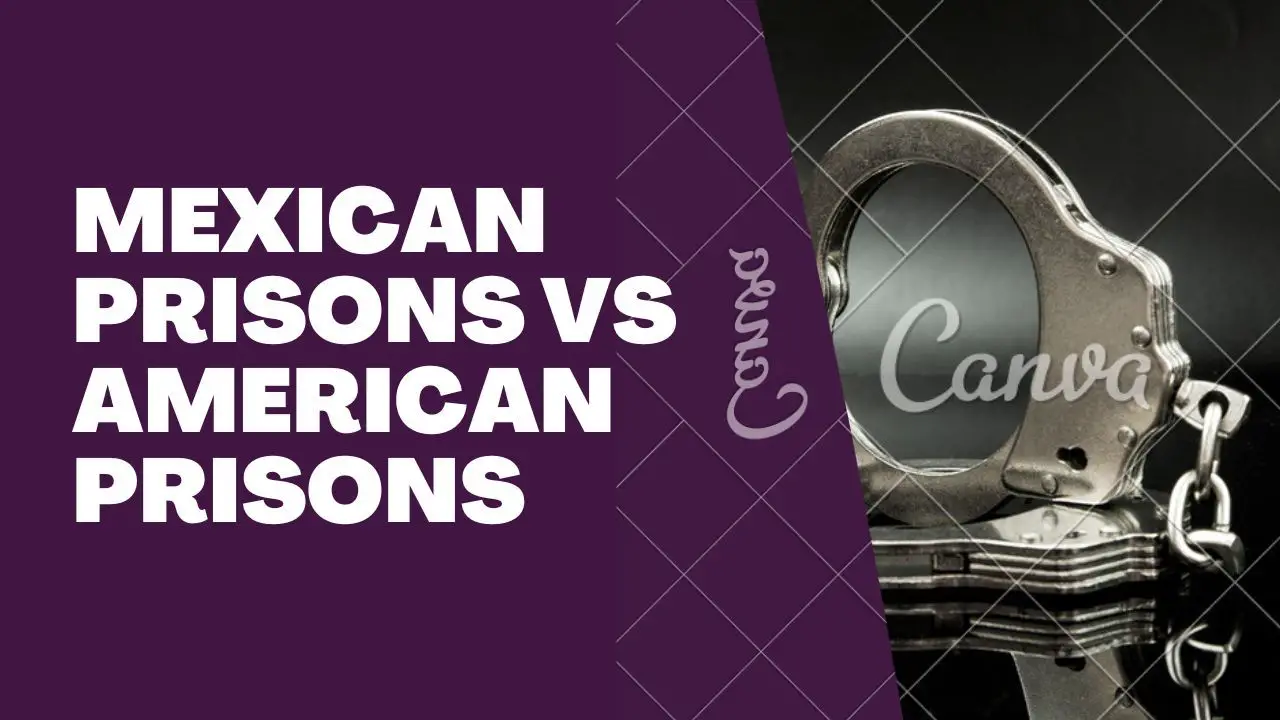Mexican Prisons Vs American Prisons: Difference and Comparison between the Two
Mexican Prisons Vs. American Prisons: Difference and Comparison between the Two Prisons located in the North American continent.

Let’s get one thing straight. Contrary to common misconception, Mexico isn’t a part of the USA but is located in the North American continent.
The two countries share a 2000-mile border and diplomatic relations. However, if you expect their prison system to be similar, they’re at two ends of a pole. Mexico generally differs from its American counterparts in various ways, which has led to significant variations in its prison operations and conditions.
Interested in Mexican prisons vs. American prisons and the factors that contribute to the dissimilarities between the two systems? You’re at the right place. We’ll cover everything that makes these systems different in this article.
Factors to Determine the Comparison of Mexican Prisons Vs. American
Legal Framework and Policies
Starting from the foundations, both prison systems have different codes of conduct. Talking about the Mexican prison system, first, the institution operates under a civil law tradition derived from the Napoleonic Code. Most European and Latin American countries also operate under this legal framework.
As per this framework, the code lays out statutory laws and regulations, which are then used to govern criminal law, civil law, and administrative law. While this framework ensures fundamental rights to prisoners, including legal representation and protection, Mexico’s prison systems have faced challenges over the years in enforcing them.
On the other hand, the American prison system operates as per the common law tradition derived from the British system. Under this framework, the rulings for any legal case take from judgments and proceedings in previous cases with similar scenarios. In other words, the court rules a case and, thus, develops legal principles and precedents for future cases.
On top of that, the Eight Amendment prohibits any unfair treatment of prisoners and safeguards their rights. Over the years, the American prison system has also been shaped by court rulings addressing various imprisonment issues, such as overcrowding, healthcare, and the use of solitary confinement.
Prison Infrastructure and Conditions
The legal framework factor would give you a hint that when discussing Mexican prisons vs. American prisons, the former has a long way to go in terms of the prison structure and inmates' living conditions. However, we’ll discuss that in detail over the next few factors.
The Mexican prison system is notorious for harsh prison conditions that make the prisoners' lives a living hell. For starters, the prisons have failed to improve their structure over the years. While there are reports of the overcrowding situation getting better, it’s still far from ideal.
Besides overloaded prison cells, the system lacks adequate facilities and resources. As an example, Mexican prisons struggle with damaged buildings and sanitation issues. Prisoners are even advised to request their family or friends to bring basic amenities due to a consistent shortage. For this reason, prisoners often struggle with stress and aggression, leading to violence and instability.
Alternatively, American prisons are considered better because of their modern facilities. The infrastructure is well-kept, and prisoners rarely have to face any issues regarding facilities and basic amenities. However, with that said, even America’s prisons could use some improvement.
Depending on the location, some prisons are still overcrowded, but, as mentioned above, work on capsizing the overcrowded situation persists. Despite the fairly doable system, there’s still a decent number of issues in these prisons, mainly violence, drug use, and gangs.
Prison Population and Overcrowding
While we’ve mentioned how overpopulation is a more incessant concern in Mexico’s prison systems compared to the US, however, both countries’ prisons still battle with this issue.
In Mexico, more people are being imprisoned, especially in recent years, than there are prisons to detain them. As of 2021, the estimated prison population was recorded at 200,000 inmates. As a result, most Mexican prisons grapple with overcrowding. Besides initial imprisonment, the excruciatingly slow process of the Mexican law institutions results in uncountable pretrial detainees, lengthy trials, and delays in alternative sentences being implemented.
The US isn’t too far behind on overcrowded prisons. It has one of the largest prison populations in the world - 2.1 million, according to 2021 records. Furthermore, the laws implemented recently have played a major role in this notion.
To elaborate, the US legal system has broken down on drug trade and drug abuse, resulting in the strict implementation of laws and sentencing policies, but so has Mexico. However, the US legal system has also introduced minimal sentencing laws enacted upon sending individuals straight to jail without a judicial judgment or individual circumstances based on only minor offenses or non-violent charges. As a result, the overcrowding issue remains prevalent in several states, but efforts are being made to combat it.
Read Can You Wear Sweatpants to a Prison Visit?
Rehabilitation and Reoffense Rates
Studies show that effective rehabilitation programs not only contribute to providing inmates with skills, education, and necessary support but also reduce their chances of relapsing into criminal offenses.
With that said, Mexican prisons severely lack proper integration of effective rehabilitation programs owing to their limited resources and infrastructure. While efforts have been made in the past few years toward rehabilitation initiatives, there’s still a lot of room for improvement. As of now, Mexican prisons are offering educational and vocational training programs, but in limited prisons across Mexico.
American prisons are ahead of their Mexican alternatives because of their extensive range of rehabilitation programs. Besides educational and skill-based training, US prisons are proficiently working on other required programs, such as substance abuse treatment and psychological support. In essence, inmates in US prisons usually get more support. However, this, too, depends on the specific prison considering not all state prisons have these rehabilitation programs in order.
The recidivism rates aren’t ideal in either of the countries when looking at Mexican prisons vs. American prisons. The Mexican National Institute of Statistics and Geography reported a recidivism rate of 45%, meaning almost half of the inmates are likely to return due to a criminal offense within a few years. However, the exact rate can’t be deduced from the complexity of the Mexican data collection methods and limited resources.
Read How Many Prisons Are In Kingston Michigan?
The US is off worse according to its recidivism rates, but that’s primarily because the US has roughly 10 times more prisoners because of its growing population. The Bureau of Justice Statistics recorded a 65% reoffense within three years and 85% within nine years.
Human Rights and Treatment of Inmates
Ensuring the implementation of human rights for inmates is crucial as per the United Nationals and international human rights organizations. For any prison system, regardless of the country, dignified treatment of inmates is foundational to a prison system. While both countries' prisons have various challenges in this context, their extent and nature differ.
Keeping that in mind, human rights violations in Mexican prisons have been a longstanding concern.
Besides deprivation of basic amenities, overcrowding, and adequate living conditions, there are unsurmountable complaints regarding violence against inmates, including inmate-on-inmate, and by the prison staff. Mexican prisons don’t have a proper healthcare system for their inmates either, even for female prisoners in dire circumstances like complex pregnancies. Other cases have also emerged regarding torture, mistreatment, and forced disappearances of inmates.
In contrast, American prisons have a greater accountability and redress situation. While the situation isn’t perfect, it’s far better than most prison systems around the world. Overcrowding and understaffing are human rights violations, but US prisons have previously used solitary confinement for unfair purposes. Another factor for criticism is the discrimination in these prisons. However, these problems are gradually being resolved through legislation and judicial rulings.
Comparing the Worst Prisons in Mexico and America
By worst prisons, we mean the prisons that leave no stone unturned in terms of maximum security and restrictions.
In America, this title goes to the “Alcatraz of Rockies,” otherwise known as the ADX Florence in Colorado. This supermax facility has a state-of-the-art design specifically for housing America’s most dangerous and high-profile inmates. For instance, Ramzi Yousef, a terrorist convicted for the 1993 World Trade Center bombing in New York, served his time in this prison. Some of the measures taken in this prison include 23-hour lockdowns, restricted human contact, and extreme security measures. Prisoners have also had to remain solitary and confined for long intervals.
Next, Mexico’s noteworthy prison is the Palacio de Lecumberri in Mexico City, nicknamed “The Black Palace” due to its appearance and dark history concerning harsh and oppressive prison life. This prison was used for the most menacing criminals in Mexico. If you’re unaware, the leader of the Gulf Cartel - Gregorio Cárdenas Hernández, was imprisoned here before being transferred. If Mexican prisons are known for their human rights abuse, this probably tops the list. However, Palacio de Lecumberri is no longer operational.
Conclusion
To summarize, an analysis of Mexico prisons vs. American prisons reveals several predominant differences between the two in terms of various aspects. From legal frameworks and living conditions to the prison population and rehabilitation efforts, both have their challenges, but the Mexican prison system struggles with it more. Overall, the US prisons have a much better system, and they continue to work on improving them further.
Read more related articles.
